Michigan's school meal experiment: Will free lunch become a permanent fixture in cafeterias?
Every student comes away from Wilcox Elementary School's salad bar with a tray that looks a little different: Some come away with stacks of cucumber slices or with bundles of carrot sticks. A handful of cherry tomatoes. A dusting of lettuce.
A Wednesday in November is quesadilla day. They are crisped at the edges and browned on top. Students can pick up small cups of salsa, sour cream and ranch dressing with their meal. And most opt for a paper carton of chocolate milk, featuring the image of Woody from "Toy Story."
The lunch lines at Wilcox, in Holt, Michigan, just outside of Lansing, are long but organized. They're longer this year, by about 75 kids, estimates Kristy Hull, head cook at Wilcox. And while that makes her job more complex, she's also saving time because she's not adding up or trying to collect on student debts for unpaid meals anymore.
"We don't want to be the bad guy," she said. "We're here to feed our kids and help them through their day."
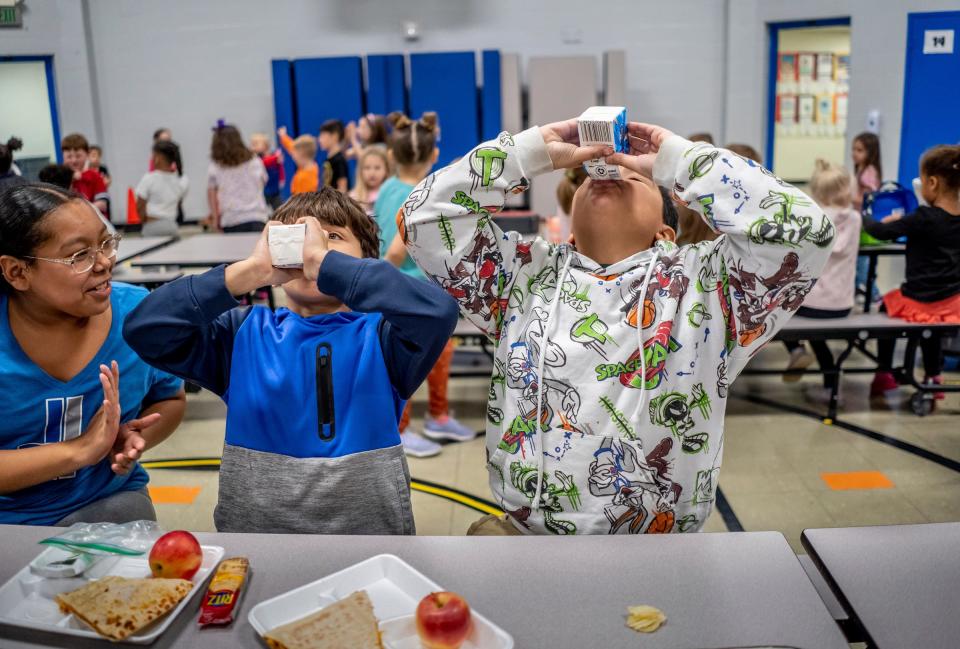
A big experiment is underway in public school cafeterias across Michigan. As a part of the state Legislature's budget for the 2023-24 school year, lawmakers allocated $160 million for the Michigan School Meals program, which makes breakfast and lunch free for all students, with no income restrictions. The state recently announced that 1.3 million of Michigan's more than 1.4 million students have access to free breakfast and lunch programs through their school.
Universal breakfast and lunch aren't a given for next year and all the years after. But it could be. State lawmakers have proposed amending state law to require the Michigan Department of Education to run a free breakfast and lunch program permanently.
"This lunch lady is happy that her dream came true to feed her students for free," said Mary Darnton, director of food service for the Jenison and Hudsonville school districts, who just ended her tenure as president of the School Nutrition Association of Michigan.
With a brand new program comes brand new hurdles and adjustments, along with a stream of new children — and their parents — experiencing school meals for the first time, raising questions about the food their kids are eating.
Morgan Surbrook, 8, a second grader at Wilcox Elementary, said her favorite school meal is pizza. And she likes that she doesn't have to fuss with money when she's hungry, she said.
Michigan's grand experiment
The total allocated for this school year — $160 million — is the state's best educated guess for cost, Diane Golzynski, deputy superintendent for finance and operations, said. Lawmakers deposited $245 million to a school meals reserve fund, so there are additional funds in case student demand overshoots the state's estimate this year.
The state is still waiting for solid numbers to get a full idea of participation and cost for possible years ahead.
"We don't have good data yet to be able to say, we're serving so many meals, we're gonna blow $160 million out of the water and we're gonna need another $100 million, or whatever it is, and we don't have any idea," Golzynski said.
Senate Bill 500, which would make the program permanent, introduced by state Sen. Dayna Polehanki, D-Livonia, and co-sponsored by a handful of Democratic and Republican state senators appears to have bipartisan support.
"A lot of middle-income families are wrestling right now with fuel costs, food costs, everything," said state Sen. John Damoose, R-Harbor Springs, during a Sept. 19 hearing on the bill. Damoose added that the stigma of getting a free lunch could stop a child from waiting in the lunch line. Universal programs help eliminate that stigma.
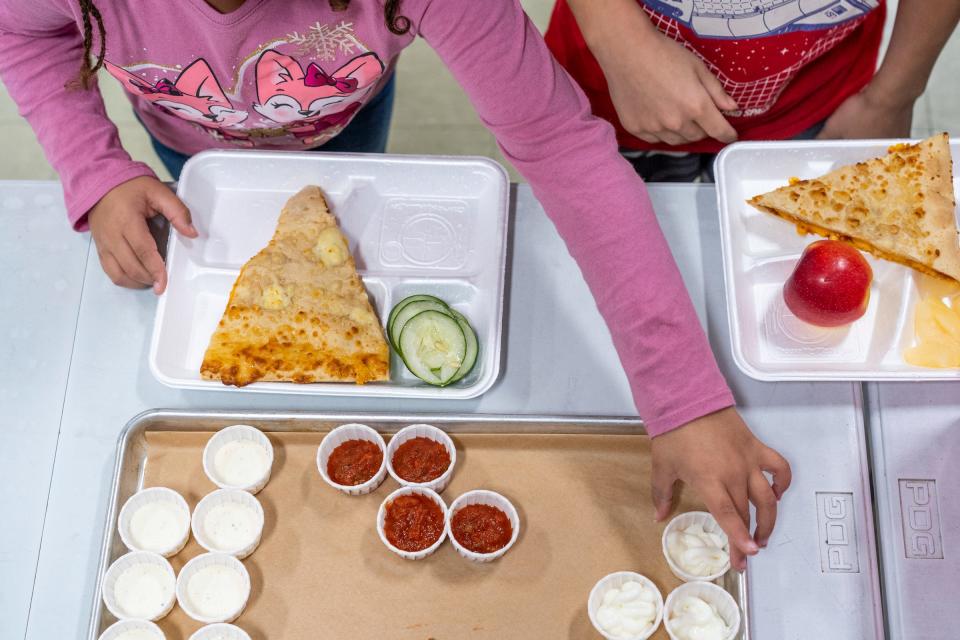
In that same hearing, Polehanki said state Sen. Darrin Camilleri, D-Brownstown Township, was instrumental in getting the funding for Michigan School Meals for the current school year. His mother works in a school cafeteria in Michigan, he said, and she is seeing a huge increase in meals served.
The Legislature adjourned early this year, in mid-November, before taking up S.B. 500. Child hunger advocates are optimistic that when lawmakers return in January, they will make school meals permanent.
Supply chain issues, lunch debt
Golzynski echoed that the number of meals served has increased, according to anecdotal observations from food service directors across the state. With more meals, food service directors have struggled to find storage for all that food, and supply chains still hampered from pandemic-era issues have also created dilemmas for those ordering food for school breakfast and lunch.
Food service directors may also be forced to get creative with purchasing this year, Golzynski said, because of the major increase in students taking part in the meal program. Schools rely on the USDA commodity program to supply cafeterias with subsidized food products, which helps stretch their dollars. But USDA funding estimates are based on the previous school year's meal numbers, Golzynski said.
"Right now, it's projected that we will run out of commodity dollars in January," she said. Those dollars in Michigan usually last until June. To compensate, districts will have to be creative about ordering.
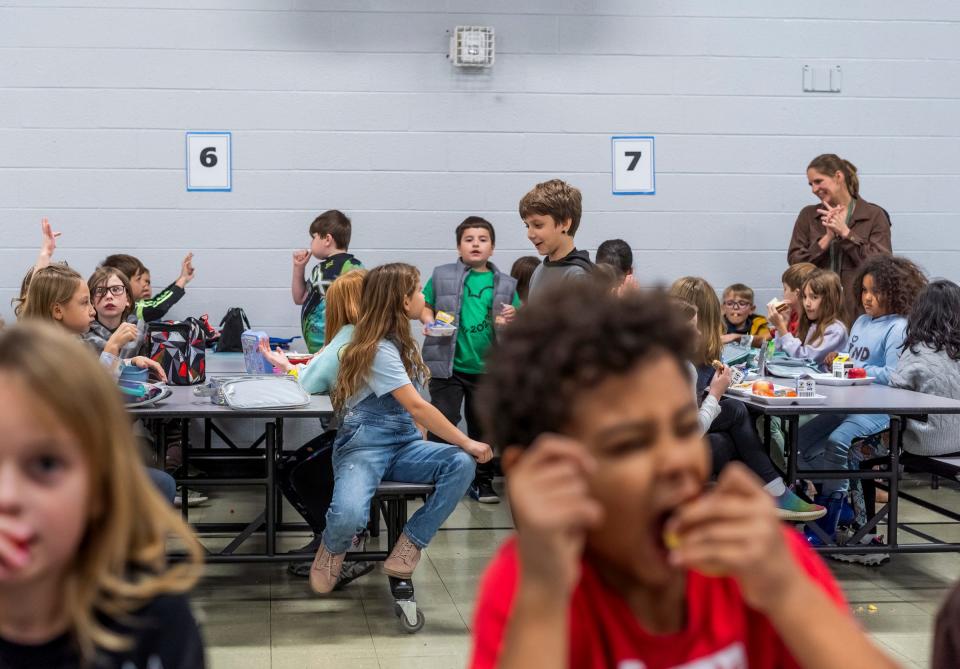
And with longer lines, the crunch time at lunchtime for students is exacerbated, she said.
"Twenty minutes beginning to end is not enough," she said. "Not even close to being enough time. So time to eat is huge."
At Wilcox, the crunch time is evident: Students line up by grade starting at 11:30 a.m. and ending around 1 p.m. Second graders are first, they dutifully know to stop at the salad bar and an aide encourages them to take a vegetable, a fruit or both.
Alexandra Wendling, a lunchtime attendant and the mother of a Wilcox student, said the free meals program has helped her family's tight budget. Wendling was once a student who received free lunch.
"Kids shouldn't have to suffer because of financial instability in their life," she said. Wendling added that removing income barriers helps kids feel equal, and think less about their status, whether they receive free lunch, reduced lunch or pay for their food.
Part of the state's plan this school year included requiring schools to wipe away existing meal debt. In Holt, the process of collecting debt in previous school years often felt endless and a process that Evan Robertson, Holt's food service director, dreaded. The district's debt limit was $20. The district would still feed students at that point, but had to give them alternate meals, usually a soy butter and jelly sandwich, Hull said.
"I hated being a debt collector for something so trivial as school lunch," he said. "Now it's gone, which has been just a godsend."
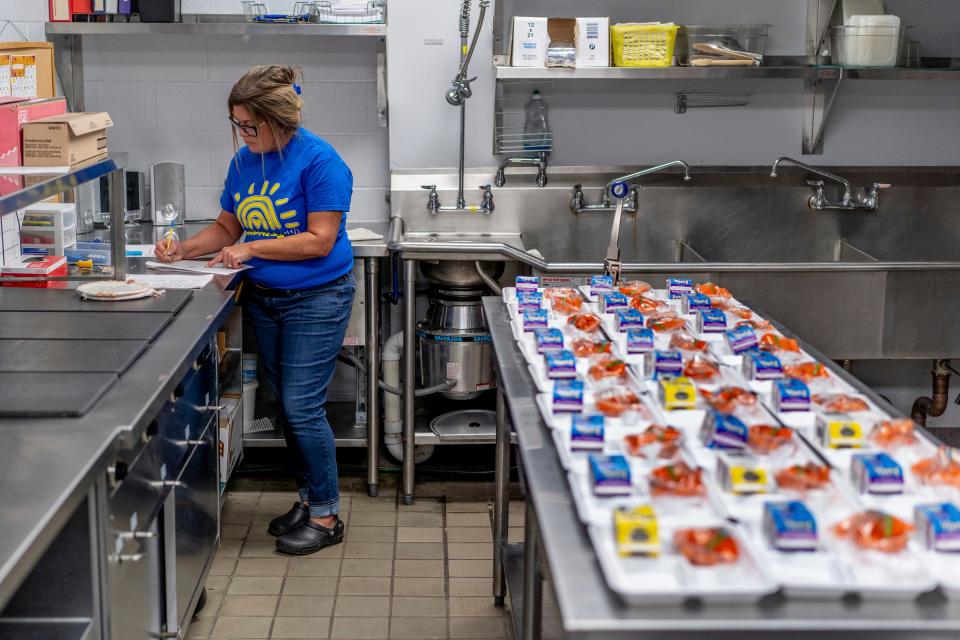
Without the added time it takes to collect meal debt, the food services director said he feels like he has "time to breathe," to think more about his meals program. He wants to work on fostering partnerships with local farms to bring fresh food into Holt's cafeterias, for example.
Universal meals are also "a win in the classroom," Robertson said, because students are more alert and more focused. Because they're fed. And he hopes lawmakers will recognize that in considering making the program permanent.
"It makes no sense to go back," he said. "That is something that I do hope that the state Legislature will take up."
Quality of school meals
Dana Mosure-Judge supports Michigan School Meals, and reducing the stigma of receiving free lunch so every kid can be fed. Her son is a kindergartner in Clarkston Public Schools, and wanted to try free breakfast and lunch, with so many other classmates participating.
But when her son brought home a wrapper for a cherry Frudel, a strudel-like pastry made by Pillsbury for school meal programs, she had questions. The pastry is made with whole grains to meet USDA requirements. But Mosure-Judge said she is discerning about what she serves her children, avoiding foods that appear overly processed.
Federal government regulations, paired with often-tight budgets, control a lot around what schools can and can't serve in cafeterias. Those regulations have for years raised questions, from a 2011 congressional decision that allowed a certain threshold of tomato paste on a pizza to count as a vegetable to a recent Washington Post investigation that found that weak standards have led to ultra-processed food making it to school cafeterias.
"Schools are doing the best they can," Mosure-Judge said. "It really comes down to the way the federal government is regulating it."
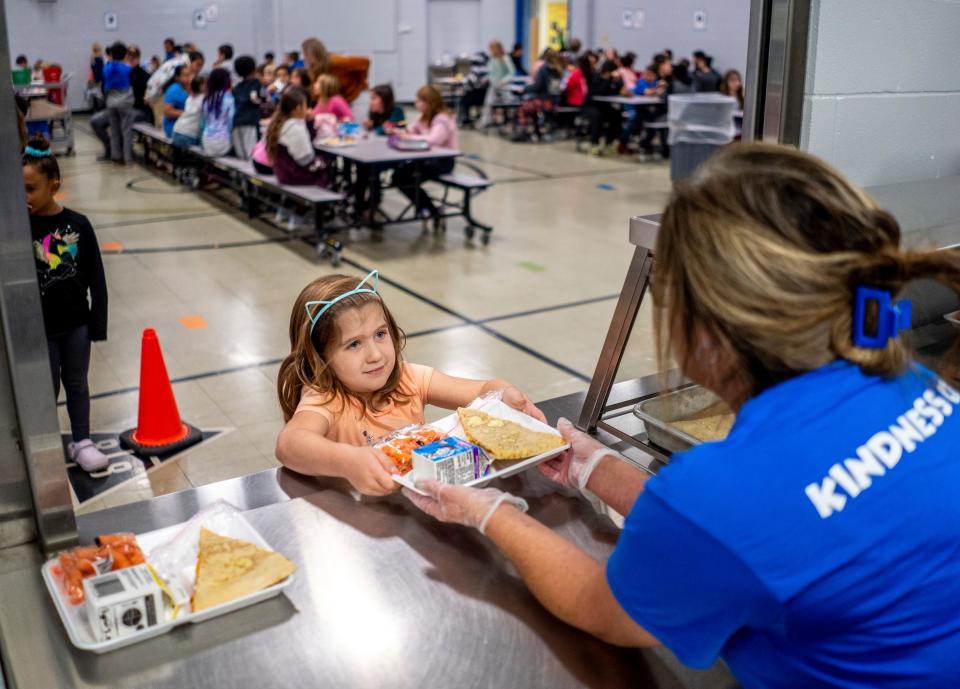
Golzynski said questions about food quality have long fueled a raging debate in the school nutrition world. But standards for parents shopping in grocery stores are different than the standards for school food directors shopping with education food suppliers. And schools often have to think about what kids will like. Adults may balk at blue applesauce, for example, but kids love it for breakfast, she said. And items like Pop-Tarts and chicken nuggets served at schools are very different from the ones sold in stores, she said.
"Chicken nuggets, they're breaded with whole grain," she said. "You don't get the same thing when you go to McDonald's. So is it that the chicken nugget is bad that's served at the school or is it just the idea of a chicken nugget that parents don't like?"
Mosure-Judge tries to have conversations often with her kids about making healthy choices. And she hopes schools will bring more fruits and vegetables onto students' plates as the school meals program continues.
"If the whole point is we're doing this free and reduced lunch so the kids get better nutrition in case they're not getting that at home," she said. "That might be a nice opportunity to introduce ... more nutrient-dense food."
But overshadowing concerns about nutrition is a feeling of relief for those working in school cafeterias like Hull, Robertson and Darnton, as they see more students joining the lunch line.
More hungry kids are being fed.
Contact Lily Altavena: laltavena@freepress.com.
This article originally appeared on Detroit Free Press: Michigan schools in 1st year of free breakfast, lunch experiment

